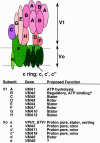The where, when, and how of organelle acidification by the yeast vacuolar H+-ATPase
- PMID: 16524922
- PMCID: PMC1393255
- DOI: 10.1128/MMBR.70.1.177-191.2006
The where, when, and how of organelle acidification by the yeast vacuolar H+-ATPase
Abstract
All eukaryotic cells contain multiple acidic organelles, and V-ATPases are central players in organelle acidification. Not only is the structure of V-ATPases highly conserved among eukaryotes, but there are also many regulatory mechanisms that are similar between fungi and higher eukaryotes. These mechanisms allow cells both to regulate the pHs of different compartments and to respond to changing extracellular conditions. The Saccharomyces cerevisiae V-ATPase has emerged as an important model for V-ATPase structure and function in all eukaryotic cells. This review discusses current knowledge of the structure, function, and regulation of the V-ATPase in S. cerevisiae and also examines the relationship between biosynthesis and transport of V-ATPase and compartment-specific regulation of acidification.
Figures



Similar articles
-
Organelle acidification is important for localisation of vacuolar proteins in Saccharomyces cerevisiae.Protoplasma. 2013 Dec;250(6):1283-93. doi: 10.1007/s00709-013-0510-2. Epub 2013 May 25. Protoplasma. 2013. PMID: 23708375
-
Yeast phosphofructokinase-1 subunit Pfk2p is necessary for pH homeostasis and glucose-dependent vacuolar ATPase reassembly.J Biol Chem. 2014 Jul 11;289(28):19448-57. doi: 10.1074/jbc.M114.569855. Epub 2014 May 23. J Biol Chem. 2014. PMID: 24860096 Free PMC article.
-
Proton Transport and pH Control in Fungi.Adv Exp Med Biol. 2016;892:33-68. doi: 10.1007/978-3-319-25304-6_3. Adv Exp Med Biol. 2016. PMID: 26721270 Free PMC article. Review.
-
The reconstructed ancestral subunit a functions as both V-ATPase isoforms Vph1p and Stv1p in Saccharomyces cerevisiae.Mol Biol Cell. 2011 Sep;22(17):3176-91. doi: 10.1091/mbc.E11-03-0244. Epub 2011 Jul 7. Mol Biol Cell. 2011. PMID: 21737673 Free PMC article.
-
Saccharomyces cerevisiae vacuolar H+-ATPase regulation by disassembly and reassembly: one structure and multiple signals.Eukaryot Cell. 2014 Jun;13(6):706-14. doi: 10.1128/EC.00050-14. Epub 2014 Apr 4. Eukaryot Cell. 2014. PMID: 24706019 Free PMC article. Review.
Cited by
-
Direct imaging reveals stable, micrometer-scale lipid domains that segregate proteins in live cells.J Cell Biol. 2013 Jul 8;202(1):35-44. doi: 10.1083/jcb.201301039. J Cell Biol. 2013. PMID: 23836928 Free PMC article.
-
A physicochemical perspective of aging from single-cell analysis of pH, macromolecular and organellar crowding in yeast.Elife. 2020 Sep 29;9:e54707. doi: 10.7554/eLife.54707. Elife. 2020. PMID: 32990592 Free PMC article.
-
Regulation of cation balance in Saccharomyces cerevisiae.Genetics. 2013 Mar;193(3):677-713. doi: 10.1534/genetics.112.147207. Genetics. 2013. PMID: 23463800 Free PMC article. Review.
-
Cryo-EM and MD infer water-mediated proton transport and autoinhibition mechanisms of Vo complex.Sci Adv. 2020 Oct 7;6(41):eabb9605. doi: 10.1126/sciadv.abb9605. Print 2020 Oct. Sci Adv. 2020. PMID: 33028525 Free PMC article.
-
Involvement of vacuolar sequestration and active transport in tolerance of Saccharomyces cerevisiae to hop iso-alpha-acids.Appl Environ Microbiol. 2010 Jan;76(1):318-28. doi: 10.1128/AEM.01457-09. Epub 2009 Nov 13. Appl Environ Microbiol. 2010. PMID: 19915041 Free PMC article.
References
-
- Abazeed, M. E., J. M. Blanchette, and R. S. Fuller. 2004. Cell-free transport from the TGN to late endosome requires factors involved in formation and consumption of clathrin-coated vesicles. J. Biol. Chem. 280:4442-4450. - PubMed
-
- Arai, H., S. Pink, and M. Forgac. 1989. Interaction of anions and ATP with the coated vesicle proton pump. Biochemistry 28:3075-3082. - PubMed
-
- Arata, Y., J. D. Baleja, and M. Forgac. 2002. Localization of subunits D, E, and G in the yeast V-ATPase complex using cysteine-mediated cross-linking to subunit B. Biochemistry 41:11301-11307. - PubMed
-
- Bauerle, C., M. N. Ho, M. A. Lindorfer, and T. H. Stevens. 1993. The Saccharomyces cerevisiae VMA6 gene encodes the 36-kDa subunit of the vacuolar H+-ATPase membrane sector. J. Biol. Chem. 268:12749-12757. - PubMed
Publication types
MeSH terms
Substances
Grants and funding
LinkOut - more resources
Full Text Sources
Other Literature Sources
Molecular Biology Databases

